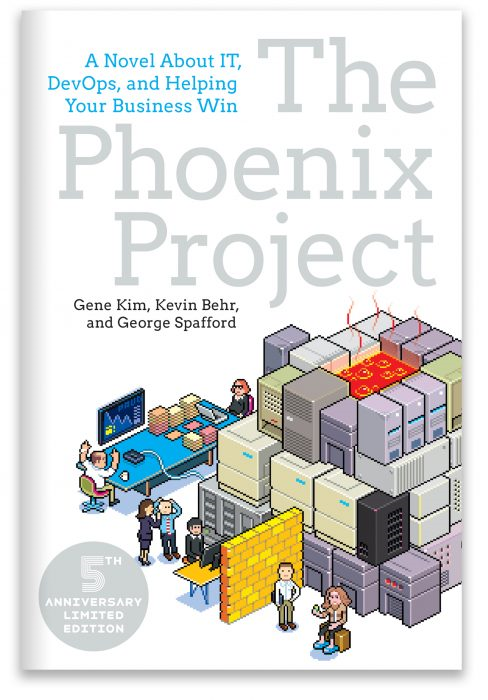As I read the book The Phoenix Project, A Novel About IT, DevOps, and Helping Your Business Win, by Gene Kim, Kevin Behr, and George Spafford, for the first time in 2013, I found myself looking around the office to see if I could spot the cameras that had quite obviously been recording the trials and tribulations of our IT development adventures.
I think that just about every IT professional reading the book will have had the same suspicions.

The difficulties being faced by Parts Unlimited, the fictional company at the heart of the book, are sadly familiar to many, if not the majority, of IT professionals. But don’t be fooled—this is not a book only for those of us who work in technology.
The Phoenix Project should be compulsory reading for all business leaders as it gives a very clear vision of how to deliver real business value through IT capability.
(This article is part of our DevOps Guide. Use the right-hand menu to navigate.)
The Phoenix Project synopsis
Parts Unlimited is a company in peril. Legacy IT systems, poor communication, badly managed change, and a lack of knowledge sharing. These factors all contribute to the company falling rapidly behind their competition in the auto parts market.
Bill Palmer is our protagonist. At the outset, he is promoted to the role of VP of IT Operations, having been happily working as the Director of Midrange Technology Operations. Bill is not convinced that he wants this challenge, given the current issues being faced by the company. But, if wants to stay employed, he has little choice in the matter.
Bill’s first challenge is to rectify a payroll system failure so their employees can be paid. On top of this major incident, he is charged with managing the deployment of the Phoenix Project, a huge IT project that the company is hanging all its hopes of turning around the downward spiral it finds itself in.
Business as usual demands, unclear processes, and unrealistic business expectations mean that Bill has a thankless, almost impossible job. Working late nights, weekends, forsaking any hope of having a work-life balance, he does his best to deliver. Bill quickly realises that this will be impossible given the current way of working at Parts Unlimited’s IT department.
DevOps: A new way of working
Reading this book for the first time in 2013, the concept of DevOps was rapidly growing in acceptance and delivering exceptional gains in IT value delivery. But it was still relatively new and, for many, a step too far.
The DevOps ideas of failing fast, accepting failure as a good thing, and pushing constant code delivery to production system were frightening concepts at the beginning of the decade. Fast forward to 2020 and DevOps, Agile, and other similar ways of working are accepted practice in organizations ranging from small start-ups to mammoth government institutions.
The Phoenix Project paints a picture that those both within and outside of the IT organization can clearly understand. The novel shows just how DevOps can:
- Improve the value delivered by IT
- Allow organizations to react quickly and effectively to market pressures
No quick fix
The Phoenix Project does not give anyone cause for unrealistic expectations. The story shows just how painful change can be and illustrates that things are not going to turn around overnight. But the novel excels at showing just how much value a DevOps mindset and way of working can deliver when given the chance.
The three authors showed the DevOps journey for Parts Unlimited in story form, with recognisable characters, plot twists, failures, and successes. The story allows the reader to see just how this way of working can be applied to a real organization with all its imperfections, different personalities, and cultural challenges. Change takes time, it can be painful, and not everybody will survive the journey.
Through Bill’s advisor Eric, we are introduced to:
- The theory of constraints
- Lean thinking
- Agile methodologies
We learn how these have impacted manufacturing operations. With guidance, it dawns on Bill that these ideas can have the same positive impact on IT development and operations.
Here is Gene Kim, one of the authors, describing the three ways (principles) of The Phoenix Project:
- Flow
- Feedback
- Culture of continuous learning
A story to be shared
The lessons learned by the characters in The Phoenix Project and the transformational possibilities presented by moving to a DevOps way of working need to be shared—not just with people working within IT. The presentation of the DevOps journey in novel form, rather than as an academic and theoretical textbook description of how to adopt DevOps, makes the subject accessible to a far wider audience.
While the novel is never going to win The Booker Prize, it is an enjoyable read with likeable characters. Best of all, it manages to humanize the theory behind DevOps.
The book clearly shows the impact DevOps can have on any organization, without making it seem like a magic wand that will magically transform your business. The novel:
- Realistically portrays the cultural and personality challenges that will inevitably threaten to derail your efforts.
- Gives valid examples of strategies on how to overcome these challenges.
Whether you are just thinking about embarking on a DevOps transformation, are some way along this journey, or are fortunate enough to have been part of a successful transformation, I strongly recommend reading The Phoenix Project. Once you’ve finished it yourself, drop a copy on to the desks of your business leaders.
The more we share this story the better!
Related reading
- BMC DevOps Blog
- DevOps Guide, a series
- Guide to Tech Books & Talks
- Lewin’s 3 Stage Model of Change
- Organizational Change Management (OCM): A Template for Reorganizing IT
These postings are my own and do not necessarily represent BMC's position, strategies, or opinion.
See an error or have a suggestion? Please let us know by emailing [email protected].






